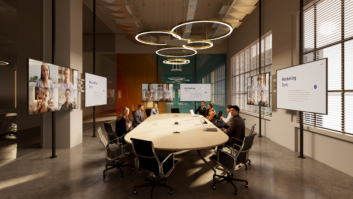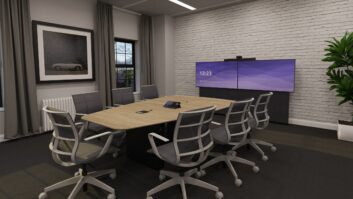The term ‘consultant’ is something of a catch-all in AV, covering several responsibilities involved in the building and deployment of an AV system. Typically, consultants conceive and design the various systems that make up the finished installation. The process begins by working with the client to ascertain their needs, then specifying the necessary technology and equipment, and liaising with the systems’ integrator. Consultants often act in a management role during the build and commissioning processes.
But these basic and fundamental duties have broadened in recent years to further include providing after-installation support and advising on pressing matters like sustainability. The consultants gathered for this roundtable have all not only seen their own jobs change in a relatively short period of time, but the whole idea of what consultancy can and should deliver.

Daniel Lee, managing director at Hewshott, observes: “Looking at the consultancy landscape over the last ten years, things have changed significantly. We used to operate in an environment where integrators did not necessarily have the design capability to handle complex spaces or deployments, so the role of the consultant was to provide that expertise. The integrator market has developed over time to a point where they are more than capable of providing good design for the most complex of systems.”
EXPERIENCE DESIGNERS
Lee continues: “Because of that our role as consultants has transitioned into one of ‘experience designers’, where we consider much more than AV, providing advice around the entire meeting or event experience from long-term strategy and room booking to working practices, service and support.”
Lee adds that by moving into this new role, Hewshott has developed associated services, including IT and acoustic consultancies. “These supplement this holistic approach to the design and deployment of systems,” he explains. “We have also added ‘Theatre as a Service’ to support clients in the traditional theatre space, but also in the deployment of broadcast studio-type spaces.”
While this evolution and broadening out of the consultant’s role has been going on for about a decade, recent events that affected the world as a whole also appear to have had an influence.
Emma Bigg, an AV design consultant for Octavius RE, comments: “Covid had a big impact on the role of the consultant in that people looked at spaces differently, which has changed their approach to technology. The necessity for remote working also really accelerated people’s knowledge and awareness of AV technology, making them much more open to both greater input from the AV consultant on a project and to using more forward-thinking technology.”
Bigg observes that the increased importance of AV as part of a construction or refit project, emphasised by investment in this aspect, has brought greater prominence to the input of consultants. “We’ve also had to up our game and broaden our knowledge, especially as we see broadcast/production technology starting to appear in corporate environments,” she says.
“When I started consulting eight years ago I was very focused on hospitality and live performance. Now my focus is more on content creation studios, corporate spaces that include sophisticated hybrid areas, which can be transformed for content creation, and incorporating the use of LED into public and retail spaces. I am definitely applying my skills and knowledge from when I worked in live events to the installation space as well.”
DIVERSE ROLES
Like others on this roundtable, Roland Hemming, project manager and principal of RH Consulting (RHC), which, as well as designing general systems specialises in audio networking, feels the nature of AV consultancy has changed. “We are working less for the end client and instead work across the entire chain,” he explains. “A great deal of what we do is working for integrators, supporting them on the audio elements of a project. We also support manufacturers in a variety of ways. Our consultancy work is extremely diverse, assisting with everything from advising financial analysts, product development with manufacturers through to traditional design and project management.”

Christian Bozeat, lead technologist for Audio Visual Upcycle, notes that in the past an AV consultant was often brought in on an installation job by a project manager, or the end user themselves, to provide stage 3 design for a project, such as an office move, to allow for tendering to systems integrators. “Some consultants are still only providing this basic service,” he says. “However, the situation is changing as users appreciate the importance of having an understanding of AV within their organisations.”
As Bozeat sees it, consultants are now providing a wide range of services as part of a project. These can include assisting in defining AV technology strategy, identifying the services needed to successfully run AV systems, helping to design AV testing processes to ensure solutions will work as intended, and also developing the scope for service and support processes. This is on top of producing a detailed design for systems and helping to develop change management processes in time for the transition.
WIDER UNDERSTANDING
Something that all consultants are now facing is a much wider scope of technological disciplines, which Bozeat says calls for different knowledge and responsibilities. “AV consultants have to understand multiple and different areas in order to deliver AV, including IT networking, testing, construction, support processes, remote monitoring and management, plus interfacing with other network services, devices and solutions,” he explains.
“The AV consultant is also very well placed to provide intelligent environment consulting, as in smart buildings, as well as construction IT consulting. A big change is in strategic consulting, which is assisting organisations to understand and deliver AV and video conferencing [VC] services long-term and how to properly support those systems internally.”
Where some consultancies have widened their area of operations to include IT and other non-AV related technologies, others are now offering highly specialised approaches and services. Among these is Faye Bennett Consultancy Services (FBCS), which does not design systems or specify equipment, but instead concentrates on what founder and managing director Faye Bennett describes as “more post-service strategy”.
This, Bennett explains, involves working with the end users to look at the overall picture of operations and maintenance to understand and manage the lifetimes of the various systems. “It’s something that traditional AV consultants don’t do as standard,” she comments. “We also work with the AV channel – everyone from manufacturers to integrators all the way along to the end users to focus on the post-sales service, including operations. But it is absolutely relevant to this discussion because it shows how consultants in the AV space are developing and how the role needs to change.”
When FBCS was founded five and a half years ago it was working primarily with AV businesses and channels, but it is now involved more with end users. Bennett says the company is increasingly engaged in decommissioning and commissioning tenders purely for service support. “This involves working with end users to understand service needs, looking at what’s painful, what’s working and how to put out a competitive tender to the market to find service providers,” she comments.
SERVICE SCRUTINY
This range of assistance and scrutiny ties in with the growing area of AV as a Service (AVaaS), although whether it signals the start of Consultancy as a Service (CaaS) is debatable. “We offer a range of services that go beyond project sign off,” Bennett comments. “Usually consultants work on deployment of the installation and then sign it off, handing it over to either an integrator to support or a managed service provider.”

She continues: “Because we focus on the service end we look at working with end users to make sure that the consultancy support goes further than that. This includes providing long-term support for governance, making sure everything was delivered in line with end user or customer needs and providing performance management if there are services providers involved – sometimes we feel that the quality of operational maintenance suffers. This is all intended to ensure that the customer gets ongoing quality management and continual improvement in service over the life of a system.”
Other members of the roundtable panel who are closer to the traditional style of consultancy agree that CaaS is not only a viable proposition but something that is in the market now.
“AV consulting is a service already,” states Christian Bozeat. “What is changing is that organisations and their IT service providers are now seeing they need in-house AV knowledge to ensure the AV services provided to their users are properly defined, delivered and supported. This requires a longer-term approach. Consultants are embedding within organisations to provide in-house knowledge, as well as assisting in structuring departments and advising the leadership on the impact of different approaches to AV design procurement and support processes.”
LONGER APPOINTMENTS
Daniel Lee, at Hewshott, adds: “The change we’ve seen in our clients though – likely due to our approach – is a move away from ‘project by project’ engagement to being appointed on a longer term and more regular basis to really become part of the client team as a partner with a view to providing support around short-, medium-, and long-term strategy, as well as other non-project specific areas.”
Both Bigg and Hemming are less convinced about the possibilities for CaaS. Bigg comments: “I think it’s dependent on the client. I’ve worked with people who look to build a relationship with their AV integrator and often that service will include advice, but this has originated from a project designed and managed by a consultant.
“Then I have other clients with whom I have worked over many years and those relationships are much more like CaaS, with me providing advice and updates to established concepts, or helping them focus on a new direction for the business and defining their technology requirements. But, admittedly, I have never worked on a formal CaaS basis.”
Hemming is more forthright, saying he does not see CaaS becoming a business model. “The role of a consultant should be to make yourself redundant,” he argues. “We want to give our clients the expertise they need for the project to be successful. They won’t want to be laboured with ongoing fees. We agree a scope, present a fixed price wherever possible, do the work and ensure the client can stand on their own two feet.”

As for what clients generally want or expect from a consultant, Hemming says a major requirement is lots of detail. “Long gone are the days of issuing a high-level performance specification,” he explains. “We often do the whole engineering package, design, schematics and even system programming. They want to know that a design is far more than a concept. In terms of the projects we are doing I think there is less traditional work directly for end clients, or construction firms acting as the overall advisor. But we find ourselves just as busy with a more diverse set of customers.”
Emma Bigg’s perspective is that what is expected of a consultant depends on the client, but nevertheless there are themes that are common to most projects: “A lot of the time I find it’s all about demystifying technology and influencing their cultural approach to technology so they can get the most benefit from solutions. AV technology is now much more pervasive and as a result there is an increased requirement for AV consultants. I think this is why large construction firms are building-in-house AV teams to be able to manage more and more sophisticated AV solutions within projects.”
Bozeat observes that what clients expect and what they actually need can be two different things. “They often want you to tell them what video systems they should have and to design AV systems for them so they can tender to integrators,” he says. “Often they don’t have an understanding of exactly what types of meetings they currently have, or what would be useful to their staff. What they actually often need initially is strategic advice on what AV and VC actually is and how it should be managed and supported internally, leading on to how to plan, design, develop and test AV systems so they actually get what they need for their organisation, with the delivery of the solutions being properly managed.”
SAFE HANDS
Daniel Lee agrees that clients are looking for both good design and support of the deployed system, but adds that being “a safe pair of hands” when it comes to the technology is critical. “For clients who do not have in-house expertise in technology design and deployment, we become part of their team, providing those skills and experience whilst always working with their best interests in mind,” he says “We are totally independent of any manufacturer or integrator, which allows us to do this.”
Faye Bennett follows up on the point about being independent, unbiased and product-agnostic. She says clients also want to know the consultant has their best interests at heart. “It’s understanding what the client wants to achieve, what their goals and ambitions are,” she says, “and what challenges they need to unpick with new AV technology. For some there might be big sustainability goals they’ve identified, or they might need to move buildings and so need to make AV decisions based on that. Which calls for us to put a lot of emphasis on discovery and really understanding the customer and their business.”
AV FUTURES
As for the future of the AV installation market as a whole and the place of consultants in it, Bennett says a side effect of the pandemic was to “bring AV into the light”, making users realise they need good systems and proper budgets for hybrid working.
Lee observes that the consultancy sector is “progressing into two distinct camps”, namely large multidisciplinary companies and the – usually – smaller firms that continue to specialise in a small number of interconnected disciplines. “There are projects that suit both and the pros and cons of each need to be carefully considered by a client when choosing a consultancy partner,” he advises.
Christian Bozeat’s view of the market is that it is fairly buoyant with interesting opportunities and an increasing understanding of the importance of video. Emma Bigg also senses a new energy in the UK following the general election. Meanwhile, the global market is energetic and the Middle East, in particular, is having a big impact on the need for consultancy and resources.
Consultants are now integral to not only the design of AV systems in a wide range of applications and installations, but it is clear their influence is expanding to meet the changing needs and concerns of their clients.





